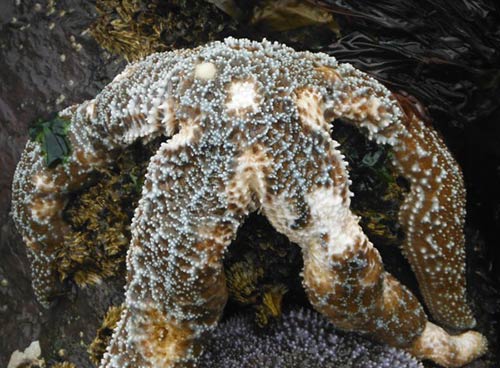
Wasting found in multiple Kachemak Bay sea starsBy DEBORAH MERCY May 15, 2015
Brenda Konar and Katrin Iken, researchers with the University of Alaska Fairbanks School of Fisheries and Ocean Sciences, found the sick sea stars while surveying long-term monitoring sites for Gulf Watch Alaska.
A sea star photographed on Elephant Island in Kachemak Bay this spring displays lesions typically caused by wasting disease.
“Many scientists thought the disease was not going to come here because our waters are too cold,” said Konar. The diseased sea stars were found in and around tide pools on Elephant Island. Damage ranged from lesions to near complete decay, with only one arm remaining. Konar said the lesions are usually the first sign of the disease. Most of the sea stars were in the genus Evasterias, a very common type in this area, but one was a Pisaster, which is much more rare in Kachemak Bay. Konar said observers have reported seeing individual diseased sea stars in Kachemak Bay in the past, but this is the first sighting that involved more than one or two individuals and that occurred in the more oceanic part of the bay. Sea stars are top predators that add diversity to their ecosystems. They prevent other organisms, such as mussels, from taking over and pushing out other species. If that were to happen, it could have a ripple effect throughout the entire ecosystem. “This is definitely cause for concern,” said Konar. “We are going to keep monitoring these sites. We’ve contacted the sea star wasting folks in California who run the program. We are on their map.” “I wouldn’t call it an epidemic“ said Konar, “but I think we can safely say it is probably here.”
Editor's Note:
On the Web:
Related:
This column is provided as a public service by the University of Alaska Fairbanks, School of Fisheries and Ocean Sciences.
|
||
